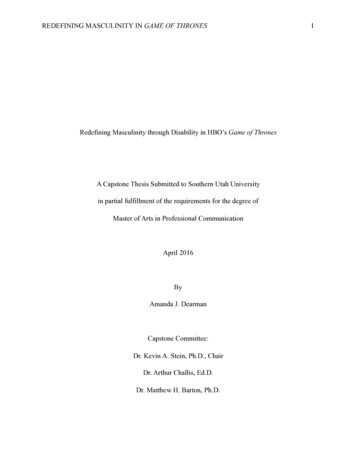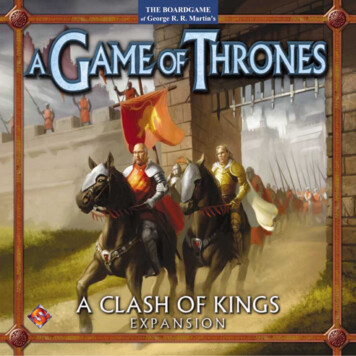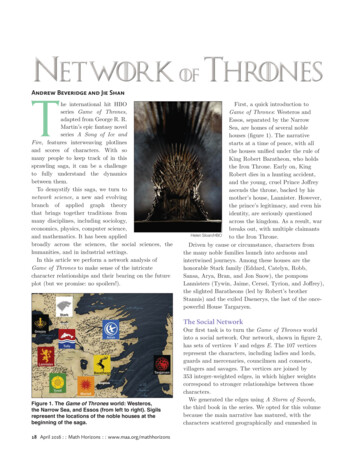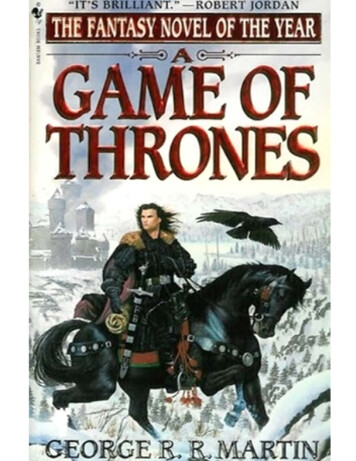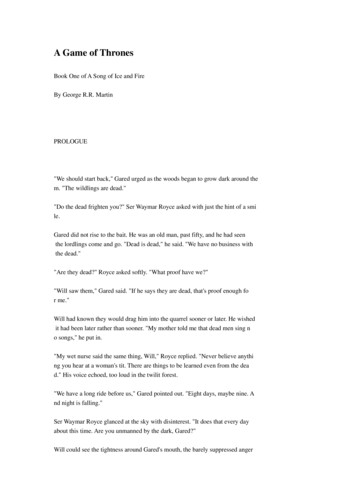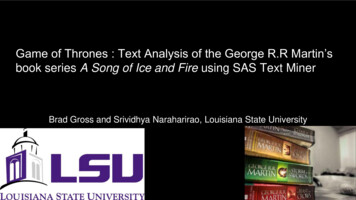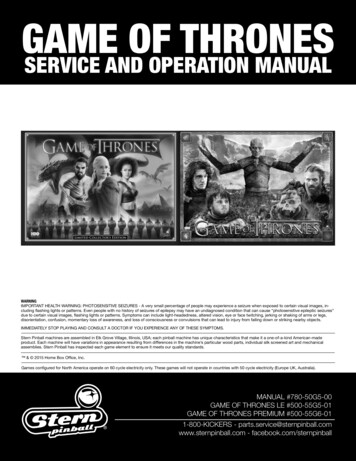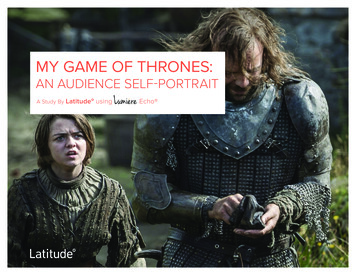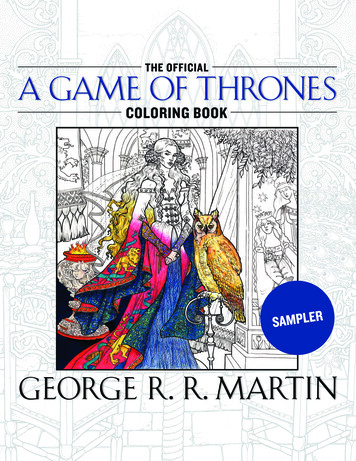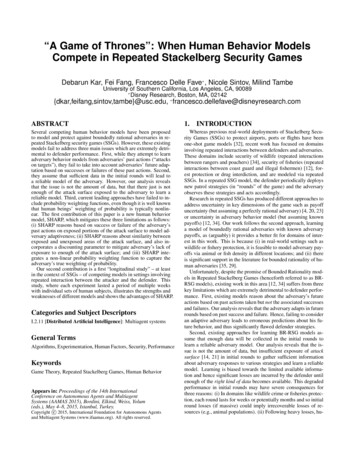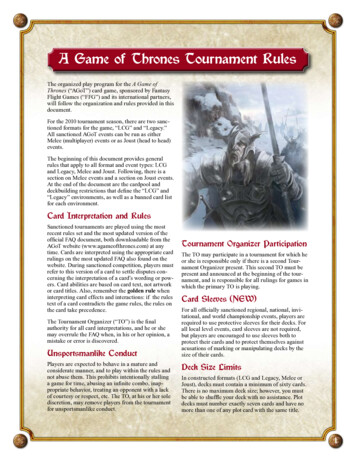
Transcription
A Game of Thrones Tournament RulesThe organized play program for the A Game ofThrones (“AGoT”) card game, sponsored by FantasyFlight Games (“FFG”) and its international partners,will follow the organization and rules provided in thisdocument.For the 2010 tournament season, there are two sanctioned formats for the game, “LCG” and “Legacy.”All sanctioned AGoT events can be run as eitherMelee (multiplayer) events or as Joust (head to head)events.The beginning of this document provides generalrules that apply to all format and event types: LCGand Legacy, Melee and Joust. Following, there is asection on Melee events and a section on Joust events.At the end of the document are the cardpool anddeckbuilding restrictions that define the “LCG” and“Legacy” environments, as well as a banned card listfor each environment.Card Interpretation and RulesSanctioned tournaments are played using the mostrecent rules set and the most updated version of theofficial FAQ document, both downloadable from theAGoT website (www.agameofthrones.com) at anytime. Cards are interpreted using the appropriate cardrulings on the most updated FAQ also found on thewebsite. During sanctioned competition, players mustrefer to this version of a card to settle disputes concerning the interpretation of a card’s wording or powers. Card abilities are based on card text, not artworkor card titles. Also, remember the golden rule wheninterpreting card effects and interactions: if the rulestext of a card contradicts the game rules, the rules onthe card take precedence.The Tournament Organizer (“TO”) is the finalauthority for all card interpretations, and he or shemay overrule the FAQ when, in his or her opinion, amistake or error is discovered.Unsportsmanlike ConductPlayers are expected to behave in a mature andconsiderate manner, and to play within the rules andnot abuse them. This prohibits intentionally stallinga game for time, abusing an infinite combo, inappropriate behavior, treating an opponent with a lackof courtesy or respect, etc. The TO, at his or her solediscretion, may remove players from the tournamentfor unsportsmanlike conduct.Tournament Organizer ParticipationThe TO may participate in a tournament for which heor she is responsible only if there is a second Tournament Organizer present. This second TO must bepresent and announced at the beginning of the tournament, and is responsible for all rulings for games inwhich the primary TO is playing.Card Sleeves (NEW)For all officially sanctioned regional, national, invitational, and world championship events, players arerequired to use protective sleeves for their decks. Forall local level events, card sleeves are not required,but players are encouraged to use sleeves both toprotect their cards and to protect themselves againstacusations of marking or manipulating decks by thesize of their cards.Deck Size LimitsIn constructed formats (LCG and Legacy, Melee orJoust), decks must contain a minimum of sixty cards.There is no maximum deck size; however, you mustbe able to shuffle your deck with no assistance. Plotdecks must number exactly seven cards and have nomore than one of any plot card with the same title.1
Pregame ProcedureBefore a game begins, players randomly determinewho goes first (see “Setup Turn Order,” below). Thismay be done any time during the pregame procedurebefore the players look at their hands. The followingsteps must be performed before each game begins:1. Players shuffle their decks. A combination ofshuffling techniques should be used to sufficientlyrandomize the deck.2. Players present their decks to their opponents foradditional shuffling and cutting. Passing a deck backto its owner verifies that you are satisfied with itsrandomization.3. If the opponent has shuffled a player’s deck, theplayer may make one final cut.4. Each player draws seven cards as their setup hand.5. Each player, in turn, decides whether to Mulligan(see “Mulligan Rule,” below). Once Mulligans areresolved, the game can begin.Setup Turn OrderThe winner of a coin toss (or other random method)is considered the First Player until the first plot card’sinitiative has been determined. This player must placehis or her cards first during setup. Once all players2have placed setup cards, all setup cards are revealedsimultaneously. Thereafter each turn follows the standard order set forth in the AGoT game rules.Mulligan RuleBefore each game begins, and before any setup cardsare revealed, a player may, for any reason, re-shufflehis or her opening hand into his or her deck, passthe deck back to his or her opponent for additionalshuffling or cutting, and draw a new setup hand fromthe same deck. This may only be performed once pergame.The decision of whether or not to Mulligan passesbetween players following the order established bythe setup coin toss. Once a player passes the opportunity to Mulligan, that player may not change his orher mind.Cards in Shadows (NEW)At the end of each game, players should reveal all oftheir cards that are in Shadows to their opponents,to ensure that no cards have been illegally placed inShadows. Failure to do so is a breech of tournamentsportsmanship, and could disqualify a player from thetournament. If a player has a strong suspicion duringa game that a card is illegally placed in Shadows, theTO can be called to verify its legality.
Official AGoT Melee Tournament RulesA Game of Thrones Melee (multiplayer) tournaments are held in a series of 105 minute tournamentrounds. Tournament Organizers (“TOs”) can adjustthis number down to 90 minutes or up to 120 minutesas they see fit. Each tournament round, players willscore points based on their order of finish within theirgame. After a predetermined number of tournamentrounds (depending on the field size and time constraints of the tournament), the top point-scorers willplay at a final table. The winner of the final table isthe winner of the tournament.SeatingThree Player Tables (Special Rule)Players are randomly assigned to a table in the firsttournament round of a Melee tournament. Each subsequent tournament round, the players from one tableshould be separated throughout the overall number oftables as evenly as possible (so that the compositionof any one table is not completely identical from onetournament round to the next), and the rest of the fieldshould then be randomly assigned to these tables.Both a player’s table and a player’s seat at that tableshould always be assigned by the TO. Tables shouldbe broken down in the following manner, dependingon the size of the field.When playing at a three player table, multiplayer titlecards are not returned to the title pool until the endof a game round in which the title pool is empty. Thismeans that in the first game round, the players willeach select one of the six titles, leaving three titlesunclaimed, still in the pool. The selected titles are notreturned at the end of the first game round, and in thesecond game round the players will choose from thethree titles they did not select in the first game round.(These titles replace their previously selected titles.)Then, at the end of the second game round, all sixtitles are returned to the pool for possible selection inthe third game round.3 players: 1 three player table4 players: 1 four player table5 players: 1 five player table6 players: 2 three player tables7 players: 1 four player table, 1 three player table8 players: 2 four player tables9 players: 3 three player tables10 players: 2 three player tables, 1 four player table11 players: 2 four player tables, 1 three player table12 players: 3 four player tablesFor Melee tournaments with more than 12 players,add an additional four player table to the closestbreakdown listed above. For instance, if there are13 players, add a four player table to the 9 playerbreakdown; if there are 14 players, add a four playertable to the 10 player breakdown, and so on. If thetournament has five or more tables, the players fromtwo tables should be redistributed throughout the fieldas evenly as possible at the start of each tournamentround.ScoringPoints in Melee tournaments are acquired by defeating your opponents. A Melee is essentially a complexseries of small battles between the players involved inthat Melee. At different points throughout the Melee,any single player may “team up” with other opponents; at other times, that player’s efforts may findhim or her trying to fend off the entirety of the field.In the end, when only one combatant is left standing,each player will be scored individually against eachof the other players in the field.When a player wins a Melee (achieves his or hervictory total), the rest of the players at the table areranked on the basis of how close each of them is totheir own victory total. Players will receive 3 pointsfor every player he or she defeats, 1 point for any tie,and 0 points for a loss. Additionally, the player whowins the entire table will receive a bonus point for hisor her efforts.3
For example: Ed, Jamie, Greg, and Sara are involvedin a Melee. All of the players are playing singleHouse decks, with no agendas, and need 15 power towin. Jamie finishes in first, by reaching 15 power. Edfinishes in second, with 12 power (3 away from hisvictory total), Sara finishes in third with 7 (8 awayfrom her victory total), and Greg finishes in 4th with2 power (13 away from his victory total). The scoringfor this finish will be as follows:Jamie (3 wins for 3 points each, plus 1 bonus pointfor winning the table) 10 pointsEd (2 wins for 3 points each) 6 pointsSara (1 win for 3 points) 3 pointsGreg (no wins, no ties) 0 pointsFor example: Aaron, Drew, Jerry, and Glen areinvolved in a Melee. Aaron, Drew, and Jerry areplaying single House decks, with no agendas. Glenis playing House Stark and a Treaty with the Isles(agenda), and each of his opponents needs only 10power to win. The game ends when Drew claims his10th power. Aaron and Jerry finish tied for second/third, with 7 power each (3 away from their victorytotal of 10). Glen finishes in fourth, with 11 power (4away from his victory total of 15).Note that “closest to victory total” is determined byan absolute number (7 is closer to 10 than 11 is to15) rather than by a percentage of the total (11/15 is ahigher percentage than 7/10).The scoring for this finish will be as follows:Drew (3 wins for 3 points each, plus 1 bonus point forwinning the table) 10 pointsAaron (1 win for 3 points, 1 tie for 1 point) 4 pointsJerry (1 win for 3 points, 1 tie for 1 point) 4 pointsGlen (no wins, no ties) 0 points4Final TableAfter the tournament preliminary rounds are complete, the top point-scorers will compete at the finaltable. Most Melee tournaments will have 2 or 3 tournament rounds of preliminaries, but this figure willalways be set by the TO before the start of the event.At Melees with 11 or fewer players, the top 3 pointscorers will compete at the final table to determinethe Melee champion. In Melee’s of 12 players ormore, 4 players will advance to the final table.In the case where a spot at the final table is contestedby a tied overall score, the players’ head to headperformance (how they finished at any table at whichthey competed against each other) is the first tiebreaker. The second tie breaker is strength of schedule, and the third tie breaker, if necessary, is a head tohead playoff, in which the player with the most powerat the end of the first game round advances. (If poweris tied at the end of the first game round, advance tothe end of the second game round, and so on, untilone player breaks the deadlock.)The player who wins the final table wins thetournament.
Multiplayer Titles: When OnePlayer “Supports” Another PlayerFor officially sanctioned Melee tournament play, thefollowing adjustment has been made to the rules ofthe multiplayer title cards.If your multiplayer title card “Supports” anotherplayer’s title card, you cannot declare challengesagainst that player. In addition, when a player yousupport is attacked by another player, if the defending player declares no defenders, you may, by virtueof your supporting title, declare any number of yourown eligible characters as defenders to that challenge.If your characters defend a challenge in support ofanother player, you are considered the winner (orloser, depending on the results) of the challenge, butthe original target of the challenge is still responsiblefor any claim that would need to be resolved. (If theattacker wins, the player for whom you have declareddefenders will still have to deal with the challenge’sclaim.) Stealth, if applicable, must be declared againsta character controlled by the player who is the original target of the attack.Table TalkDuring a Melee game, players may discuas the gamewith one another, at any time. Of course, there is noguarantee that any given player is telling the truth,and the wise AGoT player takes everything that issaid with a grain of salt. Players are not allowed,however, to show the contents of their hand, deck, orunrevealed plot cards to an opponent, unless a cardeffect or game effect instructs them to do so.For example: Jamie (with the Master of Coin title)supports Sara (with the Master of Laws title). Gregdeclares a military challenge against Sara, anddeclares stealth on her only eligible defender. Saradeclares no defenders to the challenge. Since Jamie’sMaster of Coin title supports Sara’s Master of Lawstitle, he now has the option of declaring any of hiseligible characters as defenders for this challenge.Not wanting Greg to claim a free power, Jamie takesadvantage of this option and declares one of hischaracters as a defender. If Jamie wins the challenge,he is considered the winning player for the purpose ofresponses, passive effects, and keywords like renown.If Jamie loses the challenge, he is considered thelosing player for the purpose of responses, passiveeffects, and keywords. However, Sara would still haveto satisfy the claim of the challenge if Jamie does notwin as the defender.5
Official AGoT Joust Tournament RulesJoust (head to head) tournaments for the A Game ofThrones card game are held in a series of 60 minutetournament rounds. Tournament Organizers (TOs)may adjust this number down to 50 minutes or up to70 minutes as they see fit. Each tournament round,players will score points based on the result of theirgame. After a predetermined number of tournamentrounds (depending on the field size and time constraints of the tournament), the top point-scorer is thewinner of the tournament, if there is no championshipround scheduled. For larger tournaments, the fieldwill cut to a final elimination bracket. In such a tournament, the top point scorers (usually a top 4 or top 8)will then play off in single elimination championshipbrackets to determine the tournament champion.A good rule of thumb is to always pair in halves,rather than randomly, within score groups. This allows for the subtle adjustment of players if one playerhas already played another player. (Note: If the TOhas access to rankings or ratings, or can number hisplayers by estimated strength, this will make pairingsmuch easier.)SeatingRound two example: If there are eight players in the3 score group, sort them in player number order, thenseparate into two groups, 1-4 and 5-8. Pair playernumber 1 vs 5, 2 vs 6, 3 vs 7 and 4 vs 8. If thereare seven players in the 3 score group, sort them inplayer number order, then separate into two groups,1-3, 4-7. The “odd” player is always put on the bottom stack, and will be paired down to the next scoregroup playing the highest ranked player of that scoregroup.Standard Swiss style pairings are preferred. Random pairings are allowed for the first round. The TOshould avoid pairing family members or players whotravelled together to get to the tournament, if at allpossible, for the first round. For future pairings, pairplayers within the same score group as per Swissstyle pairings.6When pairing in halves, always sort the players byscore group, then by the player number. Split thescore group in half, pairing the top half versus thebottom half.This has the same effect as using brackets so that thetop 2 players do not meet until the last round.
ScoringChampionship RoundsPlayers are awarded tournament points at the end ofeach gane as follows:If a tournament champion is to be determined bychampionship brackets, the number of players whowill make the cut into the championship bracket mustbe determined and announced before the start of thetournament. Each player’s order of finish in the preliminary rounds will determine his or her seeding inthe championship brackets; the player with the bestrecord in the preliminary rounds will play againstthe player with the worst record in the preliminaryrounds, the player with the second best record willplay against the player with the second worst record,and so on. A player moves on in the brackets witha win, a player is eliminated from contention witha loss. There is no time limit in the championshiprounds, and all games are played to their conclusion. The winner of the final game is the tournamentchampion.Match Win 3 pointsMatch Loss 0 pointsDraw 1 pointIf the time limit has been reached without a winnerbeing declared, both players are awarded a draw.These points are used to determine the winner of thetournament, or, in the case of a larger event, they areused to determine who makes the cut to the Championship elimination rounds.Breaking TiesIf a tiebreaker between players with identical win-lossrecords is needed, use the following method: Firstcheck if the players with the tie have played againsteach other. If they have, the player that won thatmatch gets the tie breaker.If they have not, award “tie breaker points” bycalculating the strength of each player’s schedule bycombining total match points of all their opponents.The player with the most tie-breaker points wins thetie and advances. This way, the person who playedthe most “difficult” games wins the tiebreaker. Thisprocedure is also called the “strength of schedule.”7
Tournament FormatsAll A Game of Thrones Melee and Joust events canbe run as LCG or Legacy format events. The cardrestrictions specific to each of these formats are presented here.Authorized Cards (NEW)LCG Format A Game of Thrones: The Card Game Core Set A Clash of Arms Chapter Pack Expansion Set(War of Five Kings, Ancient Enemies, SacredBonds, Epic Battles, The Battle of Ruby Ford,Calling the Banners) A Time of Ravens Chapter Pack Expansion Set(A Song of Summer, The Winds of Winter, AChange of Seasons, The Raven’s Song, Refugeesof War, Scattered Armies) King’s Landing Chapter Pack Expansion Set(City of Secrets, A Time of Trials, The Tower ofthe Hand, Tales from the Red Keep, Secrets andSpies, The Battle of Blackwater Bay) Defenders of the North Chapter Pack ExpansionSet (Wolves of the North, Beyond the Wall, ASword in the Darkness, The Wildling Horde, AKing in the North, Return of the Others) Brotherhood Without Banners Chapter PackExpansion Set (Coming soon!) Kings of the Sea Deluxe Expansion Set Princes of the Sun Deluxe Expansion Set Lords of Winter Deluxe Expansion Set(Summer 2010)These are the card restrictions that apply specificallyto the “LCG format” during the 2010 tournamentseason.The 2010 A Game of Thrones World Championshipswill be held in the LCG format, over two days. Dayone will be an LCG Joust tournament, and day twowill be an LCG Melee tournament. The World Champion will be the player with the highest combinedscore from both tournaments.For purposes of the LCG format, cards from the following sets are legal.Banned Cards (NEW)The following cards, even though found in the legalsets, are banned from LCG format tournament play:A Clash of Arms8 (F13) PYROMANCER’S CACHE (F43) JAQEN H’GHAR (F106) COMPELLED BY THE ROCK
Legacy FormatThese are the card restrictions that apply specificallyto the “Legacy format” during the 2010 tournamentseason.“Highlander” DeckbuildingFor the 2010 tournament Season, Legacy format willbe sanctioned with “Highlander” deckbuilding rules.This means that no more than 1 copy of any card,by title, is allowed in a deck constructed for Legacyformat play.The 2010 Legacy GenCon Championships and allother sanctioned Legacy format events will be held inthis “Highlander” format.Authorized CardsFor purposes of the Legacy format, cards from thefollowing sets are allowed, with the exception of thecards on the banned list, below.: All AGoT sets are allowed in the Legacy format. All promotional cards are allowed in the Legacyformat.Banned Cards (NEW)The following cards, even though found in the legalsets, are banned from Legacy format tournamentplay. All reprinted versions of any banned card arealso banned from Legacy format decks.Westeros Edition (R 226) KING’S PEACE (U 114) HEADS ON PIKES (R 105) COUNTERPLOT (U 151) THE THINGS I DO FOR LOVEA Flight of Dragons (R143) OUTMANEUVERWinter Edition (R233) THE GATHERING STORMA Song of Twilight (U71) PRINCE’S LOYALISTA Clash of Arms (F13) PYROMANCER’S CACHE (F43) JAQEN H’GHAR (F106) COMPELLED BY THE ROCK9
The organized play program for the A Game of Thrones (“AGoT”) card game, sponsored by Fantasy Flight Games (“FFG”) and its international partners, will follow the organization and rules provided in this document. For the 2010 tournament season, there are two sanc-tioned f
